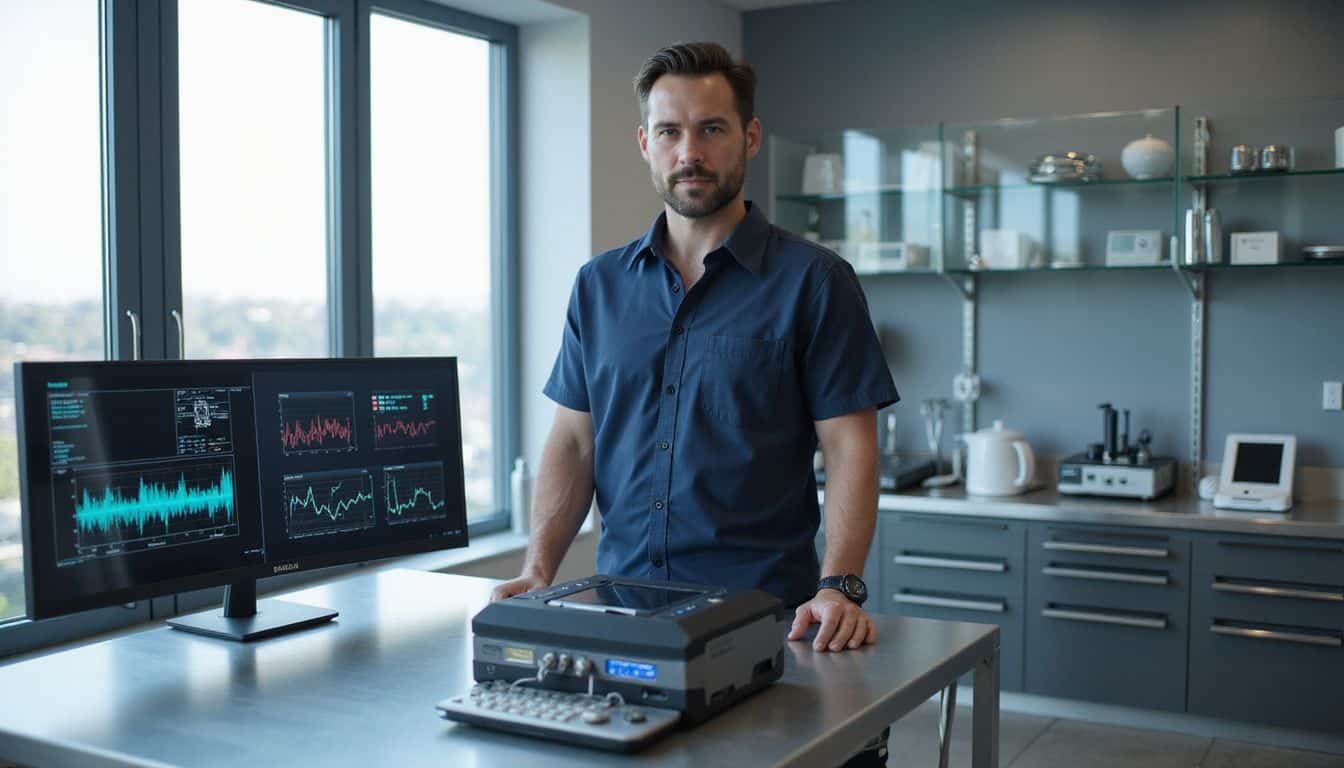Many men struggle with health issues like heart disease, diabetes, and erectile dysfunction every year. Artificial intelligence (AI) now helps doctors make faster diagnoses and better personalized treatment plans for men’s unique needs.
In this post, you’ll learn clearly how can AI improve medicine for men through 9 practical ways you can use today to boost your own health. Keep reading to find out more.
Key Takeaways
AI helps doctors detect prostate cancer 30% more accurately—and cuts unneeded heart tests by 80%.
Smart trackers catch early signs of diabetes, heart conditions, or erectile dysfunction—often before symptoms appear.
Virtual assistants allow men to privately discuss sexual health, easing embarrassment around doctor visits.
Individual care plans use AI to match treatments and lifestyle tips to each man’s health background.
AI fitness apps and wearable devices lower sports injuries by as much as 25%, checking movements and guiding safer exercise habits.
Table of Contents
AI in Diagnostics for Men’s Health

AI now spots health issues in men before symptoms show up. Smart tools scan for prostate cancer, heart risks, and other male health problems with greater speed and accuracy than ever before.
Prostate Cancer Screening

AI tools help doctors screen prostate cancer faster—and more accurately. Machine learning catches tiny changes in prostate tissue that doctors might overlook. These smart systems check MRI scans, finding cancer signs with up to 30% more accuracy than older methods alone.
Men get quicker, clearer answers—saving them from extra worry and unnecessary tests. Tools like clinical notes AI help doctors easily monitor these results and make better choices about patient care.
The future of prostate cancer screening isn’t just about finding disease, it’s about finding it earlier with greater precision.
Deep neural networks review thousands of earlier cases to understand how cancer patterns look. Doctors use this technology to decide who needs a biopsy—and who can safely skip it for now.
For men over 50, this means fewer missed cancers and fewer unnecessary procedures. Best of all, these AI tools keep improving as they see more patient data—creating personalized screening based on each man’s risk level.
Cardiovascular Risk Assessment

Doctors now use AI to quickly detect heart issues in men. One example is HeartFlow—a company that creates 3D heart maps from standard CT scans. This approach cuts unnecessary tests by around 80%, reducing healthcare costs by more than 25%.
Doctors can even check blood flow faster by using AI to analyze MRI scans. Such advances make heart care easier and more affordable for men everywhere.
Men of all backgrounds now have better access to heart care thanks to human-focused AI systems. For instance, the MIMIC database collects anonymous medical records to improve heart disease risk scores.
Also, non-English speakers with diabetes often struggle to find good care—but AI bridges this gap. Quick, easy access to heart data helps doctors build stronger treatment plans. Spotting heart issues early through AI means more time for doctors and patients to take action.
Early Detection of Diabetes

AI can now detect diabetes in men—well before symptoms show up. These smart systems check medical records, eye exams, and blood tests to catch early risks. For some men, erectile dysfunction becomes the first hint of high blood sugar, and AI connects these signals with rising glucose levels.
Machine learning tracks subtle patterns in your health data— spotting clues human eyes might overlook. Early alerts let men make lifestyle changes quickly, avoiding serious harm.
Personalized care plans come from AI systems that sift through countless treatment choices, matching options right for you. Large language models give doctors fast access to recent diabetes studies relevant to your specific situation.
Men often skip routine checkups, waiting until symptoms get serious—AI helps catch the issue sooner. Next, AI’s role in creating custom treatments designed specifically around men’s unique physical needs.
Check out more at BastionGPT.
Mental Health Diagnosis

AI tools now detect mental health concerns in men faster than traditional methods. These systems pick up warning signs—like changes in speech, facial cues, even subtle shifts in text messaging—to spot depression, anxiety, and stress early.
Many men still hesitate to talk about mental health, due to stigma or simple discomfort. Digital health platforms offer private screenings from home, giving men an easy, pressure-free way to start addressing these issues.
Technology bridges the gap for men who might otherwise suffer in silence, giving them a path to mental wellness without judgment.
Machine learning models predict who could benefit from extra support, watching for risk factors and behavioral shifts. Therapists then use these insights to shape personalized treatment plans.
Natural language processing tracks progress in therapy sessions, helping therapists understand if someone is improving or needs adjustments. Men find these digital tools helpful—making mental health care simpler, private, and a lot more effective.
Personalized Treatment Plans for Men

AI now creates custom treatment plans for men based on their unique health data, genes, and lifestyle factors — read on to see how smart tech helps doctors pick the right drugs, suggest better habits, and track your progress with pinpoint accuracy.
Tailored Therapies

AI uses your personal health data to create custom care plans for men’s health issues. Instead of a one-size-fits-all approach, smart systems now study your medical history, lifestyle, and past treatments.
For instance, men dealing with erectile dysfunction receive recommendations based on their unique factors—like specific medications, therapy methods, or even lifestyle adjustments.
So, two men facing the same issue often get different solutions, customized to fit each person’s condition and habits. These advanced systems align treatment closely to your needs, boosting chances for success.
Still, data privacy is critical here—your medical details stay protected while AI shapes your care plan. The aim is clear—more effective results, fewer unwanted reactions, and care that’s truly personal.
Medication Management

AI makes it easier for men to keep track of their medications. Smart apps notice if you’ve missed a pill and alert you early—before problems pop up. For men managing ED, these tools check hormone levels and mental wellness, helping doctors pick treatments that fit.
If side effects appear, the system can quickly adjust the meds you’re on. Some apps even scan your face to confirm you’ve swallowed the pill, helping you stay on track each day. Machine learning can rapidly test thousands of chemical combos to find potential ED medications.
This tech is handy for men who tend to miss doses, or those who might benefit from trying new treatment options.
Lifestyle Recommendations

Lifestyle shifts can greatly boost men’s health and fight erectile dysfunction. Today’s AI tools craft personalized health plans suited to your body and daily routine.
- Quit smoking right now—smoking damages vessels, lowers blood flow, worsens ED, and ups heart risks.
- Get moving for just 30 minutes every day; regular exercise improves blood circulation everywhere, reducing ED symptoms by nearly 40%.
- Drop extra pounds with smart eating; AI meal plans support weight loss while keeping your energy strong.
- Limit alcohol to two drinks each day—too much alcohol disrupts hormones and hurts sexual performance.
- Manage daily stress using meditation apps guided by AI; stress and anxiety trigger up to 20% of ED cases by activating fight-or-flight reactions.
- Aim for 7-8 hours of sleep nightly; poor rest reduces testosterone levels and increases ED problems.
- Boost intake of fresh fruits, vegetables, whole grains, and lean proteins; heart-friendly food choices improve your blood flow overall.
- Use wearable devices like smart watches and fitness bands to track progress and keep health goals on track.
- Join online support communities; connecting with men facing similar issues can increase your chances of success by 65%.
Learn more about how AI as a study tool helps men stay on track with medication schedules and treatment routines.
AI in Men’s Sexual Health

AI is changing how doctors treat sexual health issues for men. Smart systems now help spot ED causes faster and suggest better pills like tadalafil based on your health data.
Management and Treatment of Erectile Dysfunction

New technology now makes ED treatments clearer, quicker, and more personal. Machine learning tools sift through large amounts of patient data, spotting ED triggers faster—and better—than older methods.
These digital tools offer men a private space to comfortably discuss their symptoms. Doctors use these tech-driven insights to create customized treatment plans, adjusting them based on your body’s response.
Virtual health assistants provide a safe, private channel for men to open up about ED. The technology learns from patient feedback, improving treatments as time goes on. With these tools, medical providers easily review your history and pick the best combination of medications, therapies, or lifestyle adjustments.
Doctors use this tech to comfortably discuss sensitive details with patients. The result is fair, reliable care for every man who needs it.
Virtual Health Assistants for Sexual Health

AI chatbots now help men privately tackle sexual health issues. With these digital tools, guys can freely discuss sensitive topics like erectile dysfunction—without any face-to-face awkwardness.
Most men hesitate to visit doctors about intimate concerns, but virtual helpers are online around the clock. AI algorithms check personal health data and suggest specific treatments instead of generic plans.
Privacy really counts with sexual health care. Digital assistants guard personal details carefully, while still offering solid medical tips. Men also get steady support through app alerts or text reminders.
Users can monitor their progress, schedule medicine prompts, and pick up quick tips on sexual wellness. AI-powered rehab programs even guide physical improvement with focused exercises and immediate feedback.
In sports medicine, AI goes further—helping men avoid injuries during workouts or games.
Augmented Reality in Rehabilitation
 AR technology gives fresh hope to men healing from sexual health surgeries. Surgeons now wear special glasses that overlay digital body images during erectile dysfunction procedures.
AR technology gives fresh hope to men healing from sexual health surgeries. Surgeons now wear special glasses that overlay digital body images during erectile dysfunction procedures.
This smart, AI-driven setup clearly shows critical areas needing attention. Real-time image tracking guides doctors’ hands, helping them operate with more accuracy.
AR technology transforms rehabilitation by making the invisible visible to both doctors and patients.
Once surgery is done, men can check their recovery using wearable trackers. These smart devices measure pulse, blood flow, and other key signals—small details that show how your body’s doing.
The device sends data directly to your doctor, helping catch any issues early. For many men, this close monitoring helps ease anxiety, knowing their doctor can see how they’re recovering, even from home.
Improving Preventive Care with AI

AI systems now spot health risks before they become problems. Smart tools track your vital signs and warn you about possible issues based on your data.
Proactive Health Monitoring
AI can now help guys stay ahead of potential health issues. Easy-to-use tools keep an eye on your body’s signals and catch problems early, giving you an advantage in staying healthy.
- Smartwatches watch your sleep, heart rate, and daily patterns—spotting small changes before they become big issues.
- At-home test kits paired with apps track hormones and alert you to prostate concerns early.
- Virtual assistants prompt you to take medicine, schedule doctor visits, and follow your progress over time.
- Health data gets analyzed by smart software, creating personalized warnings based on your unique risks.
- Wearable tech keeps tabs on stress and nudges you to take breaks or breathing exercises to relax.
- Digital health platforms keep your medical history in one convenient place—helping doctors see patterns clearly.
- Predictive tools review your previous health records, calculating your chance for diabetes, heart trouble, and other health concerns.
- Apps send real-time tips, guiding adjustments in your meals or fitness routines to get healthier results.
- Mobile fitness trackers monitor how active you are, offering practical ideas to reach your personal goals.
- Smart health chatbots provide instant advice and support, day or night, whenever you need it.
- Electronic records combined with smart analysis give doctors quick, precise options for treatments.
- Using your specific health details, software puts together personalized plans matched exactly to your needs.
Risk Prediction Models for Chronic Illnesses
AI tools now spot your risk for serious health issues before they become a real problem. These intelligent systems study details like your age, smoking habits, weight, and activity level to catch trouble early.
For men who prefer to avoid health surprises, this kind of prediction is a huge plus. The tools do a deeper dive into medical data than typical doctor visits—often noticing little clues a quick exam might overlook.
Many systems accurately identify if you’re on track for diabetes, heart disease, or other chronic conditions, often beating out traditional tests.
To be accurate, these prediction models need plenty of your personal health info. They build a unique risk profile just for you—not a generic person around your age. That means the health warnings match your exact situation closely.
Knowing your personal risks means you and your doctor can act earlier to stay healthy. Next up, we’ll cover how smart tools help physical fitness—like sports medicine and preventing injuries.
Enhancing Men’s Physical Health

AI helps men stay fit through smart workout plans based on personal data. These systems can spot injury risks before they happen and guide safe training.
AI in Sports Medicine and Injury Prevention
AI tools today make fitness easier—and safer—for men. Apps like Lumo Run and the MotionScience Platform check how you’re running, in real-time. They spot small errors in your form—little things you may not feel but could lead to injury.
While you’re jogging, sensors follow your moves, then quickly tell you how to adjust.
Sports doctors also use AI to watch an athlete’s health closely and spot early warning signs. By seeing trends in past injuries, these tools suggest the right treatments and prevent future harm.
For guys who value staying active, these apps provide another key tool to keep workouts safe and effective.
Next up, we’ll cover how AI creates workout routines built especially for men.
Optimized Training Programs
Today, smart AI systems create personalized workout plans for men based on their own health data. These systems track heart rate, sleep quality, and even past injuries—then build routines that are safe and effective.
Medical students also use similar AI programs to quickly learn about men’s health issues. Virtual patient simulations let future doctors practice handling male-specific conditions before treating real patients.
As your workouts progress, the system adjusts along with you, pushing just enough—but safely avoiding injury. Your fitness tracker sends daily data to the system, updating your workouts based on how well you’ve recovered overnight.
Even top sports teams use this tech now, reducing player injury rates by up to 25% and keeping performance at its best.
Rehabilitation and Recovery Monitoring
AI tech now helps men recover from injuries faster—and with impressive accuracy. Smart knee braces with built-in sensors track your movements closely, catching issues early so they don’t become bigger problems.
Doctors get instant updates on your progress, letting them tweak your therapy plan right away. That’s why plenty of pro athletes rely on this type of system—they bounce back quicker and return safely to their sports.
Your progress appears in clear charts right on your phone app. The AI compares your recovery with thousands of other cases, giving you simple goals to work on each week. This setup means fewer clinic visits, letting you manage your rehab from home.
Men using these AI-supported rehab programs typically see 30% shorter recovery times compared to regular methods, plus reduced pain and improved outcomes over the long haul.
AI-Powered Drug Development and Therapy

AI speeds up drug creation for men’s health issues through smart testing and custom treatments. Read on to learn how new tech finds better medicines for prostate problems and heart disease faster than ever before.
Enhanced Drug Discovery
AI tools now help speed the discovery of drugs for men’s health issues, like erectile dysfunction (ED). These smart systems sort through thousands of chemical compounds in days—not years.
Drug companies rely on AI to find treatments for ED that have fewer side effects. The tech picks up patterns in large data sets, patterns human researchers could easily overlook. That means better medicines that hit exact targets in the body.
For men dealing with ED, this provides more treatment choices, and better outcomes as well.
Testing new drugs gets quicker and more precise with AI. It chooses suitable patients for clinical trials, then tracks their response to treatments. The tech can even forecast how a drug may work—saving time and money on clinical tests that may fail.
Personalized medications become possible, matching each man’s unique biology. And precision medicine, driven by AI advances, takes men’s healthcare another step forward.
Precision Medicine for Men’s Health
Precision medicine is changing how doctors care for men’s health. Instead of standard treatments, doctors look at your genes, lifestyle, and health history to create a personal health profile.
They use smart software—powered by artificial intelligence—to analyze your data and build custom treatments.
For instance, prostate cancer therapy now targets certain genetic markers found in your tumor. This means treatment works better for you, causing fewer side effects than older, general methods.
Genetic testing helps many men discover exactly which medicines their bodies respond to best.
AI-driven systems boost accuracy in creating your health plan. They notice subtle health patterns that humans may overlook. If you risk heart disease, smart programs offer personalized diets based on how your body handles fats.
Men dealing with low testosterone get precise dosage recommendations matched to their specific chemistry. Because of these personalized methods, simple advice like health tips for men become even more effective.
Looking ahead, doctors will continue adopting these intelligent systems. They’ll increasingly focus on fixing the root of your health issues, not treating symptoms alone.
Ethical and Practical Challenges of AI in Men’s Medicine

AI in men’s medicine faces big issues with data privacy and bias in health models – read on to learn how these challenges affect your care and what safeguards are being put in place to protect your medical information.
Data Privacy Concerns
Your health info deserves strong protection—especially when used by AI systems. Medical records hold private details about your body, illnesses, and treatments. Companies must clearly ask for your permission before using these details in AI tools.
Many men feel anxious about data breaches that could leak sensitive info—like prostate concerns, sexual health, or struggles with mental health. Healthcare providers have to use strong security, like encryption and secure servers, to keep hackers away from your data.
Limited national data about conditions like erectile dysfunction creates gaps for AI accuracy across different groups of men. Privacy concerns directly affect your comfort level with AI-driven health tools.
Addressing Bias in AI Models
AI tools for men’s health often use data that isn’t fully representative. Historically, medical studies mainly included white male participants, leading to tools that favor this group.
Because of this bias, AI sometimes overlooks health issues for men from different races or backgrounds. To address this, the MIMIC database now includes patient records from diverse groups—helping AI systems become fairer and more accurate.
Bias also happens regularly in healthcare practice itself. For example, patients who don’t speak English often receive fewer medical screenings and tests. To prevent AI from repeating these biases, careful evaluations and checks are essential.
Doctors need to review AI suggestions closely, watching out for AI-generated errors (“hallucinations”)—false information AI sometimes creates. With smarter, more inclusive design, AI can catch medical mistakes early and offer reliable healthcare support to men of every background.
Ensuring Human Oversight
Human oversight needs to stay front and center with AI in men’s health care. Doctors should double-check AI recommendations for treating ED, keeping patient safety a priority. Defining clear rules around responsibility—whether it’s doctors, technology providers, or hospitals—helps protect patients from harm.
Relying too heavily on AI alone, without human checks, may lead to errors in care. Getting this balance right ensures fair access to quality healthcare.
Experts agree these tools perform best under doctor supervision. Human validation of machine suggestions keeps patients safe. For prostate or sexual health issues, this personal oversight ensures AI supports care without causing harm.
Medical teams must monitor system outputs carefully, catching mistakes before they impact patient treatment. The aim here is using AI to support—not replace—the experience and judgment of medical professionals.
The Future of AI in Men’s Medicine

AI will soon map men’s genetic codes to spot health risks before symptoms start. Smart systems will help men track mental health daily and connect them with virtual doctors from home.
Genomic Medicine Advancements
Genomic medicine lets doctors read your DNA like a personal health map. Your genes can reveal early risks for prostate cancer, heart disease, and other common men’s health concerns—often before you notice symptoms.
Labs now deliver genetic test results in days, down significantly from weeks. Quick results help doctors catch health issues early and build a personal care plan just for you.
Testing costs have dropped sharply too—from thousands down to just a few hundred dollars within the last five years. Men now have access to personalized medicines matched precisely to their DNA.
These targeted treatments often work better and have fewer side effects than traditional drugs. Soon, your doctor could use AI to quickly scan your genes and pinpoint health risks likely to appear within the coming decade.
AI in Mental Health Support Systems
AI tools, like Woebot, now offer guys practical support for depression and anxiety—with positive outcomes. These chatbots give men a safe place to open up about tough topics, free from judgment.
Many men hesitate to reach out for mental health help due to stigma and embarrassment, but AI ensures privacy—with around-the-clock availability. Technology helps break down the barriers of shame and stigma that often keep guys silent.
These virtual assistants use cognitive behavioral therapy (CBT) techniques to walk users through helpful mental health exercises. AI tools even provide discreet guidance for sensitive issues like erectile dysfunction.
Another bonus—the technology reduces doctors’ paperwork, giving them more face-to-face time with patients. Plus, the more these systems interact with users, the better they get—creating personalized mental health approaches based on what actually helps each guy.
Integrated Telemedicine Solutions
Virtual healthcare makes it easy for men to consult doctors from home. Secure video platforms let you speak casually with urologists or mental health professionals—right from your couch.
Smart devices track real-time health data like heart rate, blood sugar, and other vital signs, sending the details straight to your doctor.
Privacy matters—especially for sensitive topics like erectile dysfunction—and online visits provide that comfort. These platforms securely store medical records, sharing details only with your assigned healthcare providers.
The best online care blends technology smoothly with real human attention, giving you improved outcomes. Research shows men feel more comfortable addressing health concerns digitally rather than in person.
Online visits reduce wait times, too, letting doctors spend more time helping patients, less time filling out forms.
How Will AI Transform Men’s Medicine in 2025?

By 2025, AI will reshape men’s health—with big breakthroughs in treating erectile dysfunction. Around 322 million men worldwide will have ED by that time. Smart AI tools will sift through massive health records, creating personalized care plans for each patient.
They’ll spot health patterns doctors often miss. AI tools will accurately predict health risks at about 90%, outperforming human doctors who average around 74%.
With AI health assistants, men can privately talk about sensitive concerns, without any embarrassment or judgment. Many guys avoid visiting doctors due to awkward conversations—but these virtual assistants solve that problem.
AI will also catch major health issues, like prostate cancer and heart risks, at earlier stages. High-speed algorithms will quickly scan medical images, noticing subtle signs of disease humans might miss.
Doctors gain extra time for patient care, as AI tackles dull tasks—like forms or sorting patient files—reducing paperwork burdens.
Still, there are challenges to solve—like protecting personal health data, and making sure AI systems perform effectively for all men. By 2025, intelligent AI support will give men quicker, smarter health care—making healthier lives easier to achieve.
People Also Ask
How is AI changing men’s healthcare?
AI is changing men’s healthcare in big ways—with quicker diagnoses and personalized care plans. Machine learning quickly spots conditions like prostate enlargement from scans, saving time and improving accuracy. Plus, wearable tech tracks daily health, giving guys more control and early warnings.
Can artificial intelligence help with men’s mental health?
Yes—AI-driven chatbots offer quick counseling support, especially helpful for men hesitant to visit a therapist. These bots use natural language technology to detect emotions and give practical mental-health tips. They’re most effective when paired with real counseling sessions.
What men’s health conditions can AI help diagnose?
AI can spot conditions like heart disease, diabetes, and urinary problems accurately and quickly. Deep learning technology scans medical images to detect problems early—sometimes noticing what doctors overlook. AI-driven systems even assist with semen analysis, helping men with fertility concerns.
How do electronic health records use AI to benefit male patients?
Electronic patient records with AI technology watch for signs of common men’s health issues. The system learns from patient data, quickly identifying risks like obesity or high cholesterol. With this knowledge, doctors can offer preventive care much earlier.
Are there AI tools men can use at home for health management?
Yes—plenty of apps use AI to track activity levels and stress. They analyze personal health data and offer tips proven effective from controlled studies. Some apps even link directly to a doctor, alerting healthcare providers to important health changes.
What future AI advances might improve men’s medicine?
AI-based drug research will soon deliver safer, more effective medications targeted to men’s health needs. Augmented reality will assist surgeons in operations, improving results and reducing errors. Also, improved biomedical informatics will significantly lower rates of misdiagnosis for men’s health issues.

